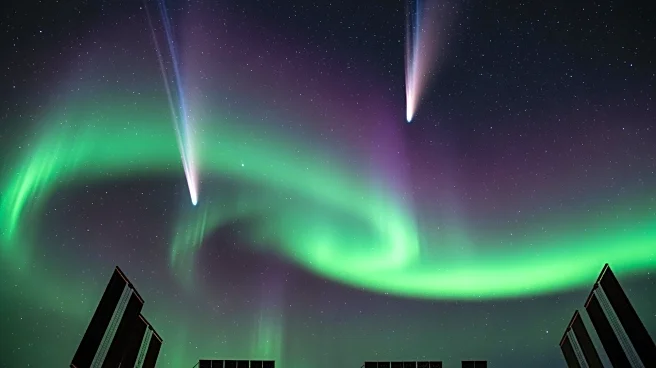What's Happening?
Astronauts aboard the International Space Station (ISS) have captured remarkable images of two comets, Lemmon (C/2025 A6) and SWAN (C/2025 R2), against the backdrop of auroras. These images were taken
during the ISS Expedition 73 and have been shared by NASA following the end of a government shutdown. The comets were photographed as they soared millions of miles away from Earth, with Lemmon appearing to merge into a vibrant aurora display. The images highlight the comets' tails, which are formed by radiation pressure and heat from the sun. The auroras, meanwhile, are created by charged particles from the sun interacting with Earth's atmosphere. Japan Aerospace Exploration Agency astronaut Kimiya Yui, who was able to post on social media during the shutdown, provided detailed descriptions of the images, noting the distinct tails of the comets.
Why It's Important?
The photographs of comets Lemmon and SWAN are significant as they provide a unique visual insight into celestial phenomena and the interaction between comets and Earth's atmosphere. These images contribute to the understanding of cometary behavior and the dynamics of auroras, which are important for scientific research. The ability to capture such events from the ISS enhances the study of space weather and its potential impacts on Earth. Additionally, the images serve as a reminder of the collaborative efforts in space exploration, involving astronauts from different countries and agencies. The documentation of these comets also adds to the historical record of astronomical events, which can be used for future research and educational purposes.
What's Next?
As the comets continue their journey through space, further observations and studies are expected to be conducted by NASA and other space agencies. These observations will likely focus on the comets' trajectories, compositions, and interactions with solar radiation. The data collected from these studies could provide insights into the origins and evolution of comets, as well as their potential impact on space missions and satellite operations. Additionally, the images may inspire further public interest and engagement in space exploration, leading to increased support for scientific initiatives and educational programs related to astronomy.











